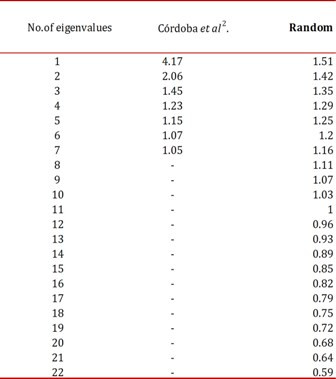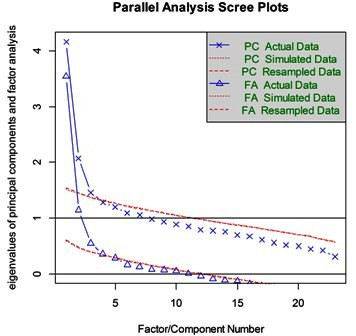Parallel analysis and MBI-HSS:
How many factors?
Cesar Merino Soto, Marisol Angulo Ramos
Mr. Editor
It has been only recently possible to validate the Maslach Burnout Inventory-Human Services Survey (MBI-HSS)
1
among health professionals of Cali
2
, an important step for using this instrument with local empirical support in regard to its reliability of scoring and internal structure. However, two aspects of this analysis can be considered as methodological weaknesses. First, the Cronbach alpha coefficient was calculated for the total group of items, and this is absolutely inappropriate because: a)the authors did not demonstrate empirical support for accomplishing this (e.g., a hierarchical factor analysis), b) the literature indicates that factors in the MBI-HSS are generally independent, a characteristic also reported by Córdoba et al.
2
,and the same authors of the MBI-HSS
1
) the authors did not report the inter-factor correlations with which an appreciation could have been obtained, at least an heuristic one of the common degree of variance among the factors.Secondly, the authors obtained seven factors in their exploratory factor analysis; this large number of actors seems to be a product of applying a factor retention method that is now consensually seen as inaccurate and little recommended
3
,
4
. Specifically, it is known as Kaiser's rule, Guttman´s rule or simply K1
4
. The problem identified with this method is its over-estimation of the number of factors to be retained
3
,
4
, a situation that clearly occurs in the results reported by Cordoba et al.
2
, as reported in their Table 2.
A more accurate method which has gained a scientific consensus for good practices for retaining the number of factors is called parallel analysis
3
,
4
. This procedure is based on the work of Horn
4
, which consists of randomly creating the same number of variables as the number of items analyzed (in the case of MBI-HSS, 22 items),correlating them and extracting eigenvalues against which the eigenvalues derived from the empirical data under analysis are compared. This procedure was applied to the eigenvalues reported by Cordoba et al.
2
, in Table 2 by means of the Monte Carlo PCA
5
program (100 replications). Our results are shown in (Table 1).
Table 1
The eigenvalues of Cordoba et al and those generated randomly (100 replications)

The appropriate number of factors to retain is achieved by making a one to one comparisons of the eigenvalues, keeping the empirical eigenvalue that is less than the random eigenvalue. Conceptually, this indicates that the significant eigenvalues must be greater than those generated randomly. In Table 1, the number of eigenvalues to retain is 3, which is exactly the same number of factors underlying the MBI-HSS. Validating the result with a conceptual analysis of these three factors, would leave one to conclude that the factorial structure of the MBI-HSS is replicable in the sample studied. Compared with the first result of the authors (7 factors), the methodological difference is clear. Finally, we note that the use of parallel analysis should be recommended for making more accurate decisions about the number of factors to retain.
Responding to: Parallel analysis and MBI-HSS.
Regarding the article, entitled "Adaptation and validation of the Maslach Burnout Inventory-Human Services Survey in Cali, Colombia" as published in Colombia Médica, please note the following clarifications:
Cronbach´s Alpha Coefficient for the total MBI scale can be considered inappropriate in the usage and evaluation of the MBI given the independence of the factors for the MBI-HSS; however, we, the authors do not share this statement as this result does not affect the conclusions of the study.
An exploratory factor analysis was used mainly as a method to cross-validate the item analysis previously conducted
1
and, secondarily, to examine the structure of relationships between variables, to detect possible multi-dimensionality of the construct assessed, and to explore the validity of the construct for the MBI-HSS so that the underlying dimensions of the items in the context could be identified
2
. From this analysis, the researchers wanted to explore the internal structure and dimensionality proposed in the theoretical model for the MBI-HSS from the data collected without making assumptions about the same model with three dimensions evaluated in the context; as the title suggests, its purpose was exploratory in nature
1
-
3
. However, later the confirmatory factor analysis was used in order to statistically contrast the hypothesis based on the grouping of the items proposed by the theory or model suggested by the MBI-HSS authors. This analysis allowed the researchers to test the hypothesis by inferential techniques and provide informative analytical options
4
. Currently, it is recommended that before proceeding with the application of a confirmatory factor analysis that exploratory factor analysis procedures are used
1
, as was previously mentioned.
For the exploratory factor analysis, Kaiser´s criterion was used as a factor retention method, although today it is not the method most recommended
6
-
8
; in numerous articles it has been used as a tool to obtain a first approximation of the factorial structure of the MBI-HSS
9
-
11
. As the more variables in the analysis the less the variance needed to explain a factor, so the Kaiser criterion tends to suggest too many factors
7
. Therefore, some suggest that it be used with other indicators
12
or that a confirmatory factor analysis is conducted to validate the number of factors
5
. Currently, parallel analysis is widely accepted to determine the number of factors to be retained
5
.
7
.
Similarly, although the exploratory factor analysis has provided a seven-factor structure, studies that have evaluated the psychometric properties of the MBI with other populations show a greater number of factors than the original version
13
-
15
by this same method.
Referencing the application of parallel analysis in the retention of the number of factors in the exploratory factor analysis (Fig. 1), it clearly shows that the results are consistent with the confirmatory factor analysis and show strong evidence in support of the three-factor structure of the original model (values greater than simulated Eigenvalues and those from re-sampling). It must be noted that the confirmatory model allows evaluation of the statistical fit between the original MBI model and our data, and the exploratory factor analysis can in no way be used as this model incorporates few substantive assumptions and allows for each item to depend on all common factors so that the interpretation is heuristic and difficult
16
. Therefore, the confirmatory factor analysis model corrects the inherent deficiencies in the exploratory perspective and leads to greater support for the hypothesis of the original structural model of the MBI-HSS.
Figure 1
Eigen values and parallel analysis over 1000 replications using the R (17) statistical software

We emphasize that through the proposed analysis one does not reject the hypothesis of a three-factor structure for evaluating Burnout syndrome in the population studied. Finally, it is appropriate to note that the researchers did not make any decision on the dimensionality of MBI-HSS through the exploratory factor analysis, but rather used the confirmatory factor analysis to decide on the factorial structure of the MBI. This analysis was done for a factorial structure of seven, six, five, four and two; however, these data were not published because a good fit of the structural equation model to a factor structure as previously found.